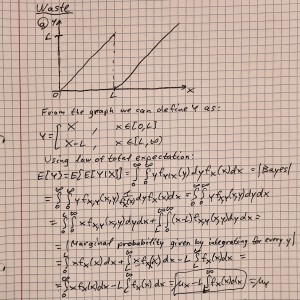Probability - Expectation calculation for a function.
A company manufactures metal poles. Suppose the length of a pole is a random variable X, with mean $\mu _X$ and probability density function $f_X(x)$ . Poles are cut to obtain an exact length 𝐿. If the initial length of the pole is less than 𝐿, the entire pole is lost. If it is greater than 𝐿, the pole will be cut down to 𝐿, and the section left over is lost. We are interested in the random variable 𝑌, defined as the length of each piece lost.
Sketch the graph of the function 𝑔 that maps the pole length 𝑥 to the lost length 𝑦, and so derive $\mu _Y$ = 𝔼(𝑌) as a function of $f_X(x)$ and $\mu _X$.
Suppose that 𝑋 follows a normal distribution with mean $\mu _X$ and variance $\sigma _X ^2$ . Show that there exists a value $\mu ^*$ of $\mu _X$ that minimizes $\mu _Y$.
Answer
- The questioner was satisfied with and accepted the answer, or
- The answer was evaluated as being 100% correct by the judge.
- answered
- 1348 views
- $5.00
Related Questions
- How do we describe an intuitive arithmetic mean that gives the following? (I can't type more than 200 letters)
- Operational research : queueing theory
- Dice expected value question
- Card riffle shuffling
- What would be the probability of "breaking the bank" in this 1985 Blackjack game? (Details in body)
- Probabilities
- Bayes theorema question, two tests (one positive, one negative)
- Differently loaded dices in repeated runs


